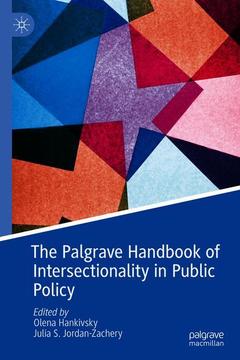The Palgrave Handbook of Intersectionality in Public Policy, 1st ed. 2019 The Politics of Intersectionality Series

TABLE OF CONTENTS
1. Bringing Intersectionality to Public Policy: An Introduction
Olena Hankivsky & Julia Jordan-Zachery
PART I: FOUNDATIONS IN THE FIELD
2. How Does One Live the Good Life? Assessing the State of Intersectionality in Public Policy
Tiffany Manuel
3. Reflecting on Am I a Black Woman or a Woman Who is Black? A Few Thoughts on the Meaning of Intersectionality
Julia Jordan-Zachery
4. Intersectionality and Public Policy: Some Lessons from Existing Models
Olena Hankivsky & Renee Cormier
5. Empirical Intersectionality: A Tale of Two Approaches
Ange-Marie Hancock
6. An Intersectionality-Based Policy Analysis Framework: Critical Reflections on a Methodology for Advancing Equity
Olena Hankivksy, Daniel Grace, Gemma Hunting, Melissa Giesbrecht, Alycia Fridkin, Sarah Rudrum, Olivier Ferlatte & Natalie Clark
7. The Difference That Power Makes: Intersectionality and Participatory Democracy
Patricia Hill Collins
PART II: INNOVATIVE METHODOLOGICAL DIRECTIONS AND IMPLICATIONS FOR POLICY ANALYSIS
8. Quantitative Approaches to Intersectionality: New Methodological Directions and Implications for Policy Analysis
Joshua Dubrow & Corina Ilinca
9. Cultivating Intersectional Communities of Practice: A Case Study of the New Mexico Statewide Race, Gender, Class Data Policy Consortium As a Convergence Space for Co-Creating Intersectional Inquiry, Ontologies, Data Collection and Social Justice Praxis
Nancy López, Michael O’Donnell, Lucas Pedraza, Carmela Roybal & Jeffrey Mitchell
10. Beyond economic barriers: Intersectionality and health policy in low- and middle-income countries
Gita Sen & Aditi Iyer
11. Lobbying suicide prevention policy for gay and bisexual men: An intersectionality-informed photovoice project
Olivier Ferlatte & John Oliffe
PART III: DIFFERENT PERSPECTIVES ON PERSISTENT PROBLEMS
12. Understanding Single Womanhood in China: An Intersectional Perspective
Crystal, L. Jiang & Wanqi Gong
13. An Intersectionality Based Framework for Tobacco Control
Jenny Douglas
14. “If they beat you and your children have eaten, that is fine…” Intersections of Poverty, Livelihoods and Violence against Women and Girls in the Karamoja Region, Uganda
Joseph Rujumba & Japheth Kwiringira
15. Through the Looking Glass: An Intersectional Lens of South African Education Policy
Michèle Schmidt & Raj Mestry
16. Scaling Educational Policy and Practice Intersectionally: Historical and Contemporary Cases from South and Southeast Asia
Mayurakshi Chaudhuri, Viola Thimm, & Sarah Mahler
PART IV: COMMUNITY ENGAGEMENT AND ADVOCACAY FOR CHANGE
17. Intersectionality and Indigenous Peoples in Australia: Experiences with engagement in Native Title and mining
Natalie Osborne, Catherine Howlett, & Deanna Grant-Smith
18. From gender-sensitivity to an intersectionality and participatory approach in health research and public policy in the Netherlands
Petra Verdonk, Maaike Muntinga, Hannah Leyerzapf & Tineke Abma
19. Intersectional Analysis of Age in the Context of Rural Health Policy in Ukraine
Anna Vorobyova
20. Intersectional Advocacy and Policymaking across U.S. States
Kathleen Marchetti
21. Bringing Intersectionality into Danish Public Policy
Heidi Lene Myglegård Andersen
22. Intersectionality and LGBTI public policies in Colombia
Camila Esguerra Muelle & Jeisson Alanis Bello Ramírezc
PART V: CHALLENGING COLONIZATION
23 Decoloniality and Emancipatory Intersectionality: The Political Organizing of Domestic Workers in Brazil
Joaze Bernardino-Costa
24. “Who will use my loom when I am gone?” An Intersectional Analysis of Mapuche Women’s Progress in Twenty-First Century Chile
Serena Cosgrove
25. How Intersectionality-based Approaches to International Development Illuminate the Plight of Palestine Refugees
Charla M. Burnett
26. Intersectional Borders in Argentina: Migration, Inequalities and Judicial Colonialism
María José Magliano & Vanina Ferreccio
27. Hearing or Listening? Pipeline Politics and the Art of Engagement in British Columbia
Sarah Marie Wiebe
PART VI: RESPONDING TO NEW AND PRESSING CHALLENGES
28. Exploring Intersectionality as a Policy Tool for Gender Based Policy Analysis: Implications for Language and Health Literacy as Key Determinants of Integration
Nancy Clark & Bilkis Vissandjée
29. The Significance of Intersectionality in Mental Health Care Policy in South Africa
Jacqueline Moodley
30. Aging-in-Place for Low-Income Seniors: Living at the Intersection of Multiple Identities, Positionalities, and Oppressions
Judith Sixsmith, Mei Lan Fang, Ryan Woolrych, Sarah Canham, Lupin Battersby, Tori Hui Ren, & Andrew Sixsmith
31. Need and opportunity: Addressing diverse stakeholders and power in the conflict over Toolangi State Forest, Victoria, Australia
Lisa De Kleyn
32. Listening for Intersectionality: How Disabled Persons Organisations have Improved Recognition of Difference in Australia’s National Disability Insurance Scheme
Cate Thill
33. Are we all ‘baskets of characteristics?’ Intersectional slippages and the displacement of race in English and Scottish equality policy
Ashlee Christoffersen
34. Timid Imposition: Intersectional Travel and Affirmative Action in Uruguay
Erica Townsend-Bell
Olena Hankivsky is Professor in the School of Public Policy and Director of the Institute for Intersectionality Research and Policy at Simon Fraser University, Canada. She is recognized internationally for methodological contributions in relation to intersectionality research and policy.
Julia S. Jordan-Zachery is Professor and Chair of the Department of Africana Studies at the University of North Carolina Charlotte, USA.
Provides relevant research to a broad range of scholars, policy actors, activists and practitioners who will benefit from insights related to the value-added application of intersectionality in their work
Offers a global perspective across a range of public policy issues and domains
Edited by leading experts in the field of intersectionality and public policy
Date de parution : 02-2019
Ouvrage de 752 p.
15.5x23.5 cm



